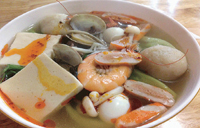Luxuriating in the island life
They are peanuts, shallots, palm sugar, garlic cloves, small bird's eye chilies, lemo or small Balinese limes, cabbage, carrots, sweet soy sauce, salt, water, cooked bean sprouts, cooked long beans, and rice cakes or lontong.
Lontong is a rice cake made by filling banana wrappers with soaked rice and boiling them for two hours before cooling.
To make the famous peanut sauce for the Gado-Gado, Juliartha grinds the peanuts, palm sugar, salt fried shallot, chilli and garlic in a blender. He lets us try slices of the palm sugar - it is dense and sweet and dark brown, leaving fine crystals on the tongue. Gradually, he adds water to give the mixture a paste-like consistency.
Next, to make the salad, he cuts cabbage and carrots into small chunks, then blanches them with some salt. The carrots, which take longer to cook, go in first. When they are done, Juliartha takes a big bowl and adds the bean sprouts, long beans, carrots and cabbage together.
Next he sprinkles fried shallots over the top, and finally he drizzles the fragrant peanut sauce on top.
Gado-Gado is frequently served with wedges of hard-boiled eggs, and Juliartha adds these and small cherry tomatoes to the mixture to complete the pretty picture.
Lastly, prawn crackers or krupuk are added to give the dish a delightful crunch. He poses with the complete dish for us, grinning from ear to ear.
By the time we are done, it is lunch time, and time to enjoy the fruits of our labor.
The fragrant peanut sauce makes the dish slightly sweet, while the krupuk and bean sprouts add both hard and soft crunch to the dish. The softness of the boiled eggs and the lontong contrasts with the springy vegetables, filling the mouth with texture and flavor.
Now this is a salad we want to recreate at home.
















